A walk and a recital in hip Shoreditch
Sat in a café in Shoreditch, reading books and articles about happiness and the neuroplasticity of the brain, I came across some research studies about the iconic London black cabs and their drivers.
In a landmark study, Maguire et al scanned these taxi drivers’ brains and found that a specific part of their brains (the posterior hippocampus, believed to play an important role in spatial memory and navigation) was significantly larger compared to controls. Based on the findings of their research, Maguire concluded that ‘there is a capacity for local plastic change in the structure of the healthy adult human brain in response to environmental demands’.
This is of extraordinary significance, as it provides evidence that the brain can change well into the adulthood. In the case of the London cabbies, it changes as a result of extensive training/learning and on-the-job experience. Indeed, in order to get a taxi license, these drivers must undergo extensive training and then pass a not-very-easy test, commonly known as the ‘Knowledge’. This was introduced as a requirement for taxi drivers in 1865. Nowadays, it takes several years for the prospective cabbies to prepare for the test. This, however, allows them to navigate through the city’s complicated road network and find the quickest route to your destination without the help of GPS or old-fashioned maps.
Oxford Street, Regent Street, Piccadilly Circus, Leicester Square. A small part of London, yet the busiest (or at least it seems this way every time I walk past these places). Don’t get me wrong; if this is your first time in London, these are some of the places you must visit. But, don’t make the mistake to assume this is all there is to the city. As any cabbie will tell you, this is only a small part of London.
A walk and a recital in hip Shoreditch
To help visitors navigate through the city’s maze of history and culture, I have teamed up with Airbnb and launched an alternative, unique and unforgettable experience for those who want to get to know the real London.
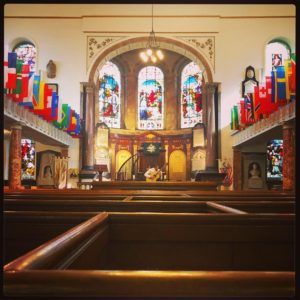
This walk will take us around Shoreditch, one of London’s coolest neighborhoods. As your guide, I will take you to places of historic and cultural interest, and make recommendations on local hangouts, to help you avoid the tourist traps and have an authentic experience. We’ll admire the eye-popping street art and have the opportunity to take arty photos. Walking around this colorful neighborhood, we’ll pass by hipster hangouts, quirky shops, and art galleries, and I’ll share recommendations about indie cafés (we may even visit one), brunch spots, street food and restaurants in this hip area. We’ll also have the opportunity to discuss the history and the culture of this hip London neighborhood.
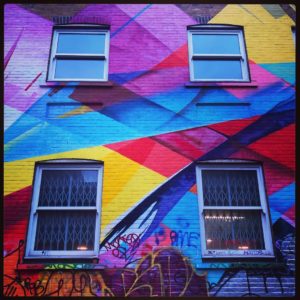
The walk
We’ll meet at Liverpool Street Station, then visit the charming Old Spitalfields Market, and continue to the 18th-century Christ Church Spitalfields. From there, we’ll walk on the vibrant Brick Lane, formerly known as Whitechapel Lane. This road takes its current name from brick and tile manufacture dating back to the 15th century. We’ll continue to the fashion-lovers’ Redchurch Street and then to Leonard Street, home to the Museum of Happiness.
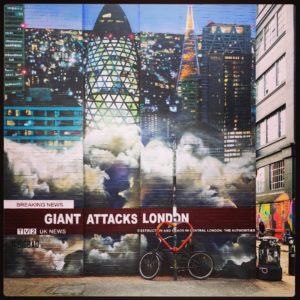
Culture
The Museum of Happiness
The Museum of Happiness is not quite like the British Museum, the Tate or the V&A. Rather than a physical space/building/gallery, it is a non-profit organization that offers interactive experiences (for example, meditation or film screenings followed by discussion and a shared meal), as well as workshops and events to promote happiness and wellbeing to the wider community. The team’s values –happiness, creativity, community, and mindfulness- echo very much mine; so does their belief that happiness is a skill that can be taught and learned.
The recital
The walk will be perfectly timed so you can enjoy a classical music recital inside the beautiful Wesley’s Chapel, one of the least known and most underrated London landmarks. This is a Methodist church, built in the 18th century under the direction of John Wesley, who founded the Methodist movement. The first thing you‘ll notice as you enter the courtyard is the statue of Wesley. There’s also a crypt housing the Museum of Methodism, and John Wesley’s House, located right next to the chapel. The recitals take place every Tuesday at 13.05 and are free to attend.
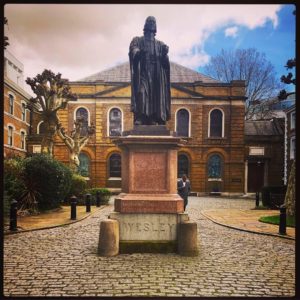
More music
If you’re more into pop/rock, then watch the video for the Killers’ song “All These Things That I’ve Done”. The UK version has been filmed on Brick Lane.
Bookshops
During this walk, we’ll pass by a number of independent bookshops that you may want to come back to. First, just off Brick Lane, there’s ‘Libreria’ (on Hanbury Street, opposite to the ‘Canvas Café’). Then, there’s the ‘Brick Lane Bookshop’ (you guessed it where). If you want to dive deeper into the world of print books, there’s also ‘Artwords’ on Rivington Street.
Street art
Shoreditch is renowned for the ever-changing but nonetheless eye-catching street art, some of which has been created by Banksy. Brick Lane, Redchurch Street, New Yard Inn, Shoreditch High, Great Eastern, and Rivington Street provide the perfect canvas for the street artists.
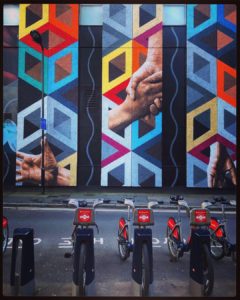
Food and drinks
Cafés
Street art aside, if there’s one thing in abundance in Shoreditch, this will have to be the indie cafés.
Following our trail from Liverpool Street Station to Wesley’s Chapel, we’ll pass right between ‘Nude Espresso’ (a café, on the right hand) and ‘Nude Coffee Roasters’ (a roastery, on the left hand) on Hanbury Street before we turn left on Brick Lane. We’ll walk past the Old Truman Brewery, where the London Coffee Festival takes place every year, and continue towards the deceptively spacious ‘Kahaila’ (on the left-hand side on Brick Lane). We’ll then turn left on Redchurch Street, and we’ll pass several cafés. ‘Barber & Parlour’ is co-located with a salon and the ‘Electric Cinema’. It sits right opposite to ‘Allpress Espresso Bar’, a tiny café renowned for its coffee. ‘Modern Society’ is located in a store selling designer clothing.
We’ll then cross Shoreditch High Street; the boutique ‘Ace Hotel’ with its hipster café ‘Bulldog Edition’ is further on the right. As we continue on New Yard Inn, we’ll pass by ‘Visions Canteen’. Then, we’ll cross Great Eastern Street; the Shoreditch branch of the ‘Attendant’ is further on the right. Approaching Wesley’s Chapel, we’ll pass by ‘Ozone’ on Leonard Street, and ‘Lantana’ on City Road. ‘Grind’ on Old Street (at the roundabout) is not far from there.
A happy café
The ‘Canvas Café’ is London’s first ‘happy café’ (the very first ‘happy café’ opened in Brighton); it is situated on Hanbury Street, just a few meters from Brick Lane. It is part of the Happy Café Network, set up in 2014 by Action for Happiness, a movement launched in 2011 and based on the idea that ‘people commit to living in a way which creates more happiness – both for themselves and for others too’. The Happy Café Network now includes more than 30 cafés around the UK, and even more across the world. These are places where ‘those seeking happier lives for themselves and others can connect with each other over a coffee and learn science-based skills for enhancing psychological wellbeing’. Like in the Museum of Happiness, here you can participate in experiential activities (mindfulness, meditation, yoga), watch films or join talks about wellbeing and happiness.
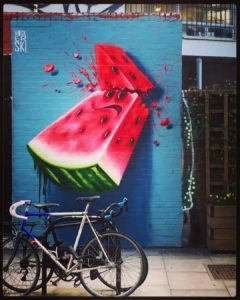
Eating out
Brunch
In addition to the aforementioned cafés, most of which serve brunch, there are plenty of other brunch spots in the area. My favorite is ‘Albion’ on the corner of Redchurch and Boundary Street. Here you will also find the Shoreditch branches of ‘Dishoom’ (opposite ‘Albion’) and ‘Andina’ (on the corner of Redchurch and Shoreditch High Street); both restaurants are renowned for their brunch (pun intended).
Street food
Restaurant food in London is rather pricey for both visitors and locals. For lunch, street food is a less expensive but excellent alternative. There are numerous choices around the city and in Shoreditch. There’s the Old Spitalfields Market, where local restaurants (i.e. ‘Lahpet’) have stalls serving some of their signature dishes. Then, there’s the Sunday Street Market on Brick Lane, as well as the two Jewish beigel shops, the white-fronted ‘Beigel Bake’ and the yellow-fronted ‘Beigel Shop’, both open 24/7. During the week, there are several stalls in the junction of Leonard and Paul Street. When the weather’s good, you can take your lunch to the nearby Mark Street Gardens.
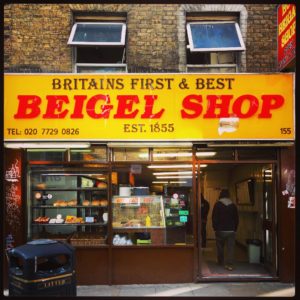
Restaurants
Two restaurants stand out for me: ‘Galvin La Chapelle’ and ‘Tramshed’. As the name suggests, ‘La Chapelle’ is a –Michelin-starred- French restaurant housed inside a (former) chapel (St Botolph’s Hall) on Spital Square, while ‘Tramshed’ is located on Rivington Street, in the heart of Shoreditch. The latter’s unusual name makes sense once you consider that it is housed in an early 20th-century building that used to be an electricity generating station for trams. Inside, the iconic ‘Cock ‘n’ Bull’ installation by Damien Hirst gives the impression of being suspended from the high ceiling; it also gives a clue as to what you’ll find on the menu.
For a more exotic culinary experience, I would recommend ‘Lahpet’, a modern Burmese restaurant on Bethnal Green Road. If you fancy something more old-fashioned, then go no further than Brick Lane. Lined with a large number of curry restaurants, it is a reminder that here beats the heart of the Bangladeshi community of London. You won’t find any animals suspended over your head, nor will you be dining inside a chapel; all the while the food won’t disappoint you.
Bars
Last, but not least, let’s not forget ‘Happiness Forgets’ (pun intended), a speakeasy-style subterranean bar on Hoxton Square. It proudly sits on the 35th position on the list of the World’s 50 Best Bars for 2018. ‘Nightjar’ is another hip basement bar. Located on Old Street, it is renowned for both its cocktails and the live jazz and blues music.
Further reading on London
These are some of my favorite books and guides about London:
The 500 Hidden Secrets of London
33 Walks in London That You Shouldn’t Miss
An Opinionated Guide to East London
Further reading on neuroplasticity and happiness
Check out my article on neuroscience, neuroplasticity and happiness:
Buddha’s Brain: The neuroscience of happiness
The following books are also worth reading:
Buddha’s Brain: The Practical Neuroscience of Happiness, Love, and Wisdom co-authored by neuropsychologist and meditation teacher Rick Hanson and neurologist Richard Mendius is an interesting, as well as enjoyable, book to read, as it sheds light on the workings of the brain, whilst focusing on what an individual can do to reduce their suffering and improve their wellbeing.
The Chimp Paradox: The Mind Management Programme to Help You Achieve Success, Confidence and Happiness by Prof Steve Peters explains how the brain and mind works, but also provides suggestions on how to better manage your mental world.
To follow my travels around the world, simply subscribe to the Traveling Psychiatrist (just click on the menu on the left hand side).
Last but not least, come and join me for a walk and a recital in hip Shoreditch.
Alex
(the Traveling Psychiatrist)